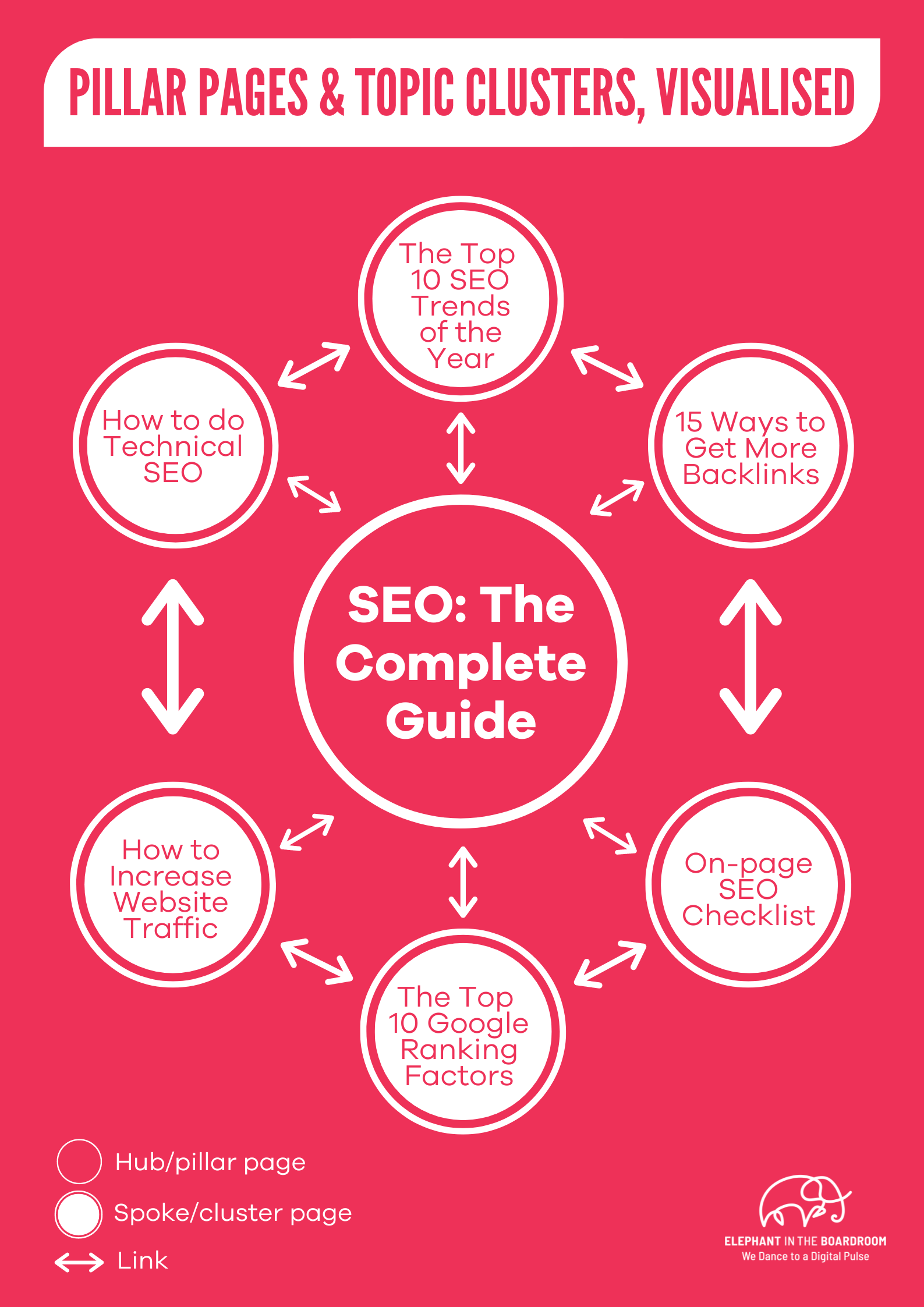
What is a Pillar Page & How Can It Boost Your SEO?
A pillar page is essential in improving your website’s SEO and its ability to appear first in the search results. How so?
Internal linking is an important step in increasing your website’s SEO potential, especially this year, where opportunities are nigh. In order to appear first in search engine results pages (SERPs), you must optimise the content published on your website.
This is where pillar pages come in.
Find out what you need to know about pillar page and how you can leverage them to their full advantage.
What is a pillar page?
Pillar pages are landing pages on a page that is focused on a specific topic, subject, or resource, commonly referred to as the topic cluster. Pillar pages serve as the central resource for other pages in the cluster that are linked to a specific topic of interest or subject on your website.
Typically, pillar pages are titled “the ultimate guide”, “what is X”, or “how to do Y”, which then directs the website visitor to multiple blogs, articles, or content relevant to the topic of interest.
To better understand, consider the connection between pillar pages and topic clusters to be the hubs and spokes of a bicycle wheel.

In this example, one website dedicated to SEO can have a pillar page dedicated to it, such as “SEO: The Complete Guide”. The pillar page is intended for anyone visiting the page to learn more about SEO. Naturally, the page viewer wants to learn more about SEO and is likely to want to read more about it. Referring to the infographic, you can see the cluster pages are indicated as smaller circles. These can be blogs, articles, or other relevant content. All of the cluster pages are linked to each other, as indicated by the arrows.
How do pillar pages improve SEO?
There are numerous reasons why pillar pages can help your website’s SEO in the long run, from improved content archiving to increased website access numbers.
It helps to improve site structure.
Pillar pages and topic clusters are essential for improving your site structure, which is critical for your future SEO rankings. It aids in the organisation of your website’s contents, by sorting out content topics from your website for easier access for page viewers.
Google crawler, also known as Googlebot, and crawlers from other search engines will be able to easily crawl within your website. The easier it is for Google to crawl your website, the easier it is for Google to find, index, and rank your pages.
It strengthens topical authority signals.
Google measures the content that you publish on your website using Expertise, Authoritativeness, and Trustworthiness (E-A-T). This allows Google to calculate the overall quality score of your content.
Using pillar pages and topic clusters on your website helps searchers determine your website’s expertise, thus associating your website with a specific field or business. It also further improves your search rankings by making it simple for search engines to identify, understand, and rank your content.
It helps rank your competitive keywords.
Because pillar pages are the website’s repository of its relevant content, they must include competitive keywords, as well as broad keywords.
This means, that you require a long-form piece of content that contains all of your competitive keywords that are related to your website. If you pile up those keywords within your articles, you will almost certainly generate traffic, backlinking, and increased SEO visibility. The effect will be contagious, as topic cluster pages linked to the pillar page will be viewed as well.
It gives your page visitors a better, user-friendly experience.
By organising your website’s contents through the use of pillar pages and topic clusters, you are already doing your current and incoming page visitors a great service. You make it simple for users to find information and content that is relevant to them. It will also benefit you because the page viewer is guaranteed to stay longer on your site browsing deeper through the content provided on the page
Google has been incentivising better user experience in websites by awarding them with priority points in search engine optimisation. And, the creation of Core Web Vitals is one manifestation of their commitment to making web usage a positive experience for all users. Taking advantage of Google’s incentives will significantly improve the SEO of your website.
It boosts your link-building capabilities.
As link building is one of the many reasons for the creation of pillar pages and topic clusters on your website, more benefits will be unlocked by the links that connect them.
You are not only providing page visitors with information that is useful and informative by directing them to their desired pillar page but you are also being provided with a free channel to promote your other related content resources by directing them to their desired pillar page. How about that for a freebie?
How to create a pillar page for SEO?
After determining the scope of content within your site, as well as the likely topic clusters, you are now ready to create pillar pages that will aid in your website’s SEO. Here are the steps as follows:
1. Understand What a Pillar Page Is
A pillar page is a comprehensive piece of content that covers a broad topic in-depth and links to other, more detailed pieces (cluster content) on related subtopics. Think of it as the central hub of a wheel, with all the spokes (subtopics) connecting back to it.
Example: If your website focuses on digital marketing, a pillar page could be titled “The Ultimate Guide to Digital Marketing”. This page will cover various aspects of digital marketing in-depth and link to more detailed articles on topics like SEO, social media marketing, email marketing, and pay-per-click advertising.
2. Choose a Relevant Topic
Your pillar page should centre around a broad topic that aligns with your niche or industry. This approach ensures that your pillar page remains relevant and valuable to your audience while covering a wide range of related subtopics.
For instance, if you manage a fitness blog, your main page might be titled “The Comprehensive Guide to Healthy Living.” This topic is broad enough to encompass various aspects of fitness and wellness, such as nutrition, exercise routines, mental health tips, and lifestyle changes. However, it should still be specific enough to appeal to your target audience who are interested in improving their overall health.
3. Conduct Keyword Research
Keyword research is crucial. Identify the main keyword for your pillar page and long-tail keywords for your cluster content. Opt for tools such as Google Keyword Planner, SEMrush, or Ahrefs to discover keywords that offer high search volume and minimal competition.
Example: Using Google Keyword Planner, you might find that “Digital Marketing Strategies” is a high-volume keyword. For subtopics, you might choose long-tail keywords like “SEO best practices for 2024” or “how to use social media for business growth”.
4. Plan and Write High-Quality Content
Plan the structure of your pillar page. Aim for comprehensive, engaging, and informative content. Use subheadings, bullet points, and images to make it easy to read. Ensure each section is detailed and provides value to the reader. Remember, the goal is to be the go-to resource on the topic.
Example: For the pillar page titled “Exploring Australia”, your outline might look like this:
- Introduction: Why Australia is a top travel destination
- Section 1: Popular Australian Cities (e.g., Sydney, Melbourne, Brisbane)
- Section 2: Best Australian Beaches
- Section 3: Adventure Activities in Australia
- Section 4: Cultural Experiences in Australia
- Conclusion: Tips for planning your Australian adventure
In the “Popular Australian Cities” section, you might write: "Sydney, Australia’s vibrant harbour city, offers iconic landmarks like the Sydney Opera House and Harbour Bridge. Melbourne, known for its cultural diversity, boasts a thriving arts scene and world-class dining. Brisbane, the capital of Queensland, features a warm climate and beautiful river views."
5. Link to Cluster Content
As you write, link to your cluster content. These are more detailed blog posts that dive deeper into specific subtopics.
Example: Within the “Best Australian Beaches” section, you could link to a more detailed post titled “Top 10 Beaches to Visit in Australia”. This helps readers find more specific information and enhances the SEO of both pages.
6. Optimise for SEO
Make sure your pillar page is SEO-friendly. Use your main keyword in the title, headers, meta description, and throughout the content, but avoid keyword stuffing. Optimise images with alt text and ensure your page loads quickly. A well-optimised page is more likely to rank higher in search results.
Example: For the pillar page “The Ultimate Guide to Digital Marketing”, you might include:
- Title Tag: The Ultimate Guide to Digital Marketing | Your Go-To Resource"
- Meta Description: Discover everything you need to know about digital marketing with our comprehensive guide. Learn about SEO, social media, email marketing, and more.
- Header Tags: H1 for the main title, H2 for section headings, H3 for subsections.
7. Promote Your Pillar Page
Once your pillar page is live, promote it across your marketing channels. Share it on social media, include it in your email newsletters, and consider running paid ads. The more traffic your pillar page gets, the better it will perform in search engines.
8. Update Regularly
SEO isn’t a one-and-done deal. Regularly update your pillar page with new information, statistics, and links to fresh cluster content. Keeping your content current signals to search engines that your page is relevant and authoritative.
Conclusion
It only seems like a small part of your website, but utilising the power of pillar pages and topic clusters can be the beginning of a positive SEO outcome for your website. So, if we were you, let us assist you in getting on board. Elephant in the Boardroom’s SEO expertise might be the one missing link your website needs.
Talk to us at www.elephantintheboardroom.com.au so we can get started!





















